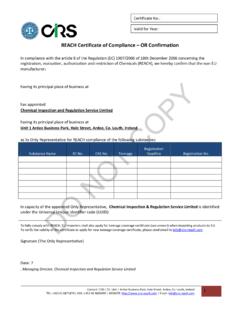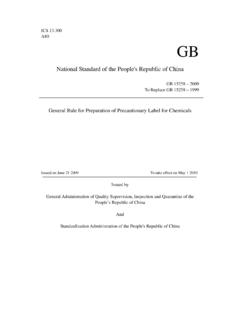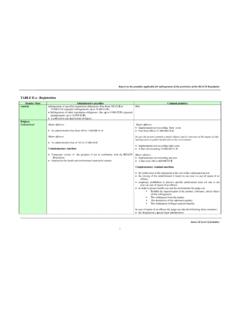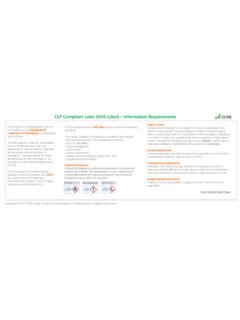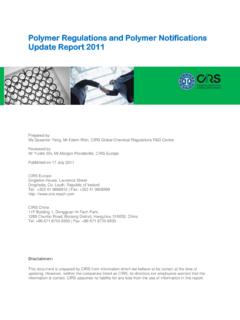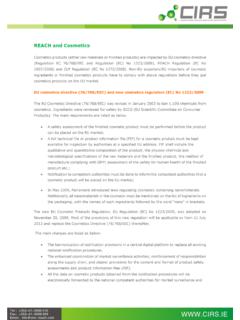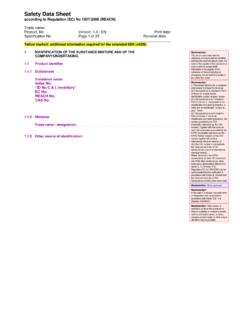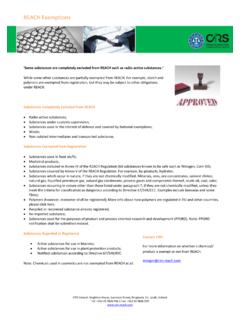Transcription of ICS 13.300 A80 GB - Chemical Inspection and …
1 ICS A80 GB National Standard of the People's Republic of China GB 13690 2009 Replaces GB 13690 1992 General Rule for Classification and Hazard Communication of Chemicals Issued Date: June 21 2009 Implementation Date: May 1 2010 Issued by General Administration of Quality Supervision, Inspection and Quarantine of the People s Republic of China and Standardization Administration of the People's Republic of China GB 13690 2009 Foreword Chapters VI and V in the Standard are mandatory, whilst the rest are recommended. The conformity degree between this Standard and its corresponding regulation, the second revised edition of Globally Harmonized System of Classification and Labeling of Chemicals (GHS) ((ST/ ), is non-equivalent.)
2 This Standard s technical contents are is conformity with those of the GHS. In accordance with 2000, some editorial changes have been made to the Standard s format. The main differences between this Standard when compared to GB l3690 1992 Classification and Labels of Dangerous Chemical Substances Commonly Used are: - The Standard s title is changed into General Rule for Classification and Hazard Communication of Chemicals ; - In accordance with the requirements set forth in the GHS, the Standard sets up hazard classification of chemicals; and - In accordance with the requirements set forth in the GHS, hazard communication of chemicals is stipulated in the Standard. Annexes A, B, C and D to the Standard are informative appendices.
3 This Standard is proposed by and is under the jurisdiction of the Dangerous Chemicals Management of Standardization Administration of China (SAC/TC251). The organizations that participated in the drafting of this Standard: Chemical Engineering Standardization Research Institute of China; Shandong Entry-Exit Inspection & Quarantine Bureau; Shanghai Chemical Research Institute; Jiangsu Entry-Exit Inspection & Quarantine Bureau; and Hubei Entry-Exit Inspection & Quarantine Bureau The main drafters of this Standard: ZHANG Shao-Yan, CUI Hai-Rrong, YANG Yi, WANG Xiao-Bing, MEI Jian, TANG Li-Jun, CHE Li-Dong, CHEN Hui-Ming and ZHOU Wei. This Standard replaces the previously issued Standard: - GB 13690 1992. GB 13690 2009 General Rule for Classification and Hazard Communication of Chemicals 1.
4 Scope The Standard specifies the classification and hazard communication of chemicals in consistence with the GHS. The Standard applies to the classification and hazard communication of chemicals. Besides, the Standard governs the labels of Chemical workplaces and of Chemical consumer goods. 2. Normative References The provisions of the following documents become provisions of this Standard after being referenced. For dated reference documents, all later amendments (excluding corrigenda) and versions do not apply to this Standard; however, the parties to the agreement are encouraged to study whether the latest versions of these documents are applicable. For undated reference documents, the latest versions apply to this Standard. GB/T 16483 Material Safety Data Sheet the Order of Contents and Subtitles GB 20576 Safety rules for classification, precautionary labeling and precautionary statements of chemicals Explosives GB 20577 Safety rules for classification, precautionary labeling and precautionary statements of chemicals Flammable gases GB 20578 Safety rules for classification, precautionary labeling and precautionary statements of chemicals Flammable aerosols GB 20579 Safety rules for classification, precautionary labeling and precautionary statements of chemicals Oxidizing gases GB20580 Safety rules for classification, precautionary labeling and precautionary statements of chemicals Gases under pressure GB 20581 Safety rules for classification.
5 Precautionary labeling and precautionary statements of chemicals Flammable liquids GB 20582 Safety rules for classification, precautionary labeling and precautionary statements of chemicals Flammable solids GB 20583 Safety rules for classification, precautionary labeling and precautionary statements of chemicals Self-reactive substances GB 20584 Safety rules for classification, precautionary labelling and precautionary statements of chemicals Self-heating substances GB20585 Safety rules for classification, precautionary labelling and precautionary statements of chemicals Pyrophoric liquids GB20586 Safety rules for classification, precautionary labeling and precautionary statements of chemicals - Pyrophoric solids GB20587 Safety rules for classification, precautionary labeling and precautionary statements of chemicals Substances which, in contact with water, emit flammable gases GB20588 Safety rules for classification, precautionary labeling and precautionary statements of chemicals Corrosive to metals GB20589 Safety rules for classification, precautionary labeling and precautionary statements of chemicals Oxidizing liquids GB20590 Safety rules for classification, precautionary labeling and precautionary statements of chemicals Oxidizing solids GB20591 Safety rules for classification, precautionary labeling and precautionary statements of chemicals Organic peroxides GB20592 Safety rules for classification.
6 Precautionary labeling and precautionary statements of chemicals Acute toxicity GB20593 Safety rules for classification, precautionary labeling and precautionary statements of chemicals Skin corrosion/ irritation GB20594 Safety rules for classification, precautionary labeling and precautionary statements of chemicals Serious eye damage/ eye irritation GB20595 Safety rules for classification, precautionary labeling and precautionary statements of chemicals - Respiratory or skin sensitization GB20596 Safety rules for classification, precautionary labeling and precautionary statements of chemicals Germ cell mutagenicity GB20597 Safety rules for classification, precautionary labeling and precautionary statements of chemicals Carcinogenicity GB20598 Safety rules for classification, precautionary labeling and precautionary statements of chemicals Reproductive toxicity GB20599 Safety rules for classification, precautionary labeling and precautionary statements of chemicals Specific target organ systemic toxicity Single exposure GB20601 Safety rules for classification, precautionary labeling and precautionary statements of chemicals Specific target organ systemic toxicity Repeated exposure GB20602 Safety rules for classification, precautionary labeling and precautionary statements of chemicals Hazardous to the aquatic environment GB/T 22272 GB/T 22278 Serial Standards over Good Laboratory Practice (GLP)
7 ISO 11683:1997 Package Exposure Hazards Warning Requirements International Program on Chemical Safety/Environmental Health Criteria - No. 225 Document Principles for Evaluating Health Risks to Reproduction Associated With Exposure to Chemicals GB 13690 2009 3. Terms & Definitions A series of the National Standards (GB 20576 GB 20599, GB 20691 & GB 20602) converted from the GHS as well as the following terms and definitions shall apply to this Standard. Chemical identity It refers to a name to solely identify a Chemical product. The name can either meet the IUPAC Chemical nomenclature/CAS Chemical nomenclature or can be a technical name. Compressed gas It refers to a kind of gas which is completely at the gaseous stage at the temperature of 50 C; moreover, it includes all the gases whose critical temperatures are higher than 50 C.
8 Flash point Flash point of a volatile liquid is the lowest temperature (as adjusted to the standard air pressure of kPa) at which it can vaporize to form an ignitable mixture in air where an ignition source shall be used under proper experimental conditions. Hazard category It refers to the classification for each hazard class. For instance, acute oral toxicity comprises five hazard categories whereas inflammable liquid comprises four hazard categories. The categories with serious hazards cannot be compared to those with general hazards within the same hazard class. Hazard class It refers to the property of physical hazards, health hazards and environmental hazards, such as inflammable solid, carcinogen, acute oral toxicity and etc.
9 Hazard statement Hazard statements are standardized and assigned phrases that describe the hazard(s) as determined by hazard classification. The degree of the hazard is also included in hazard statements when appropriate. Initial boiling point It refers to the recorded temperature at which the first drop of distilled vapor is liquefied and falls from the end of the condenser when vapor pressure of the liquid is equal to the standard pressure ( kPa). Label It refers to a combination of words, printings or pictograms descriptive of a hazardous product. A label is selected due to its relevance with target sectors. The label is attached to or inscribed to the container or outer packing for the product.
10 Label element Label elements refer to the information on a label, such as pictograms and signal words Recommendations on the Transport of Dangerous Goods, Model Regulations A formal publication entitled Model Regulations on the Transport of Dangerous Goods as an appendix to the UN Recommendations on the Transport of Dangerous Goods approved by the United Nations Trade and Development Board. Pictogram It refers to a picture comprising a hieroglyphic symbol and other pictographs, such as label border, background pattern or color, to convey a specific message. Precautionary statement A precautionary statement is a phrase (and/or pictogram) that describes the recommended measures that should be taken to prevent/minimize adverse effects from exposure to a hazardous product or improper storage or handling of the product.
